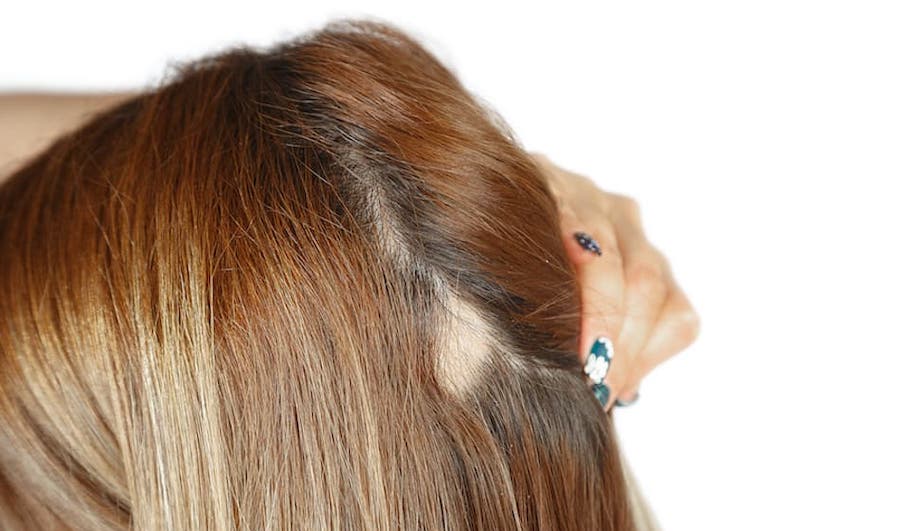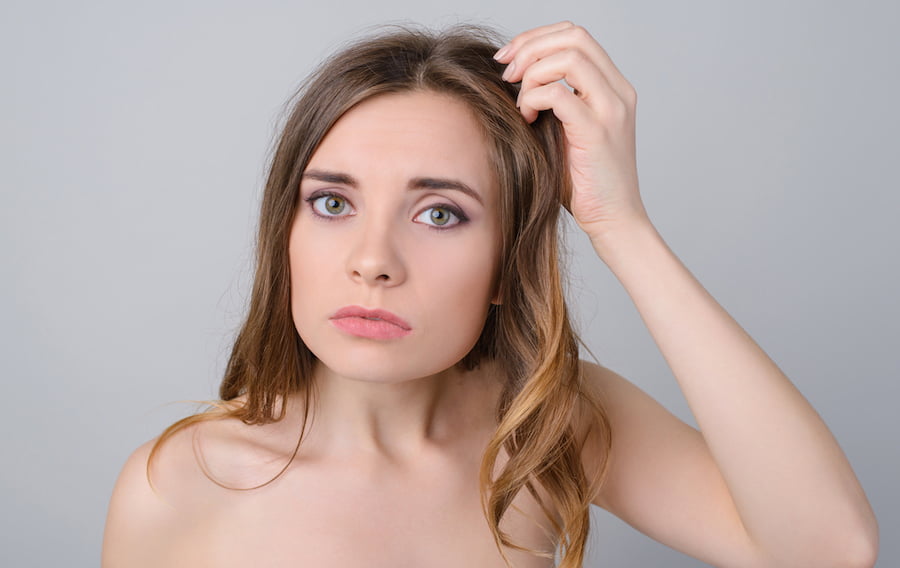
Traction Alopecia: Causes, Treatment, and Prevention
Have you heard of traction alopecia? Ever wondered why those seemingly harmless tight ponytails you wore every day suddenly started causing discomfort?
Or why your love for hair extensions has led to thinning hair? You’re not alone.
Hair loss from hairstyles and hair care practices that pull your hair too tightly is more common than you might think.
This condition, known as traction alopecia, is a silent cause of hair loss that can be stopped in its tracks once identified and addressed.
Short Summary
-
Traction alopecia is a hair disorder caused by tight hairstyles and extensions.
-
Symptoms of traction alopecia include hair breakage, receding hairline, and scalp discomfort.
-
Prevention strategies such as wearing loose braids/ponytails & limiting the use of extensions can help protect against damage from traction alopecia.
What Is Traction Alopecia
There are different types of hair loss.
Traction alopecia is a silent hair loss, it stems from the continuous pull on your hair follicles due to tight hairstyles and certain hair care practices.
Imagine your hair as a plant rooted in the soil. If you keep pulling the plant from its roots, it will eventually weaken and detach. That’s exactly what happens when your hair is tightly pulled, contributing to hair loss.
This condition, one of the various hair disorders, was first documented in 1907 in Greenland, where individuals experienced hair loss along their hairline due to prolonged wearing of tight ponytails.
But it doesn’t stop there. Other hairstyles can also take a toll on your hair health, especially in individuals of African descent due to their unique hair texture and styling techniques.

I LOVE MY HAIR NOW
FullyVital hair serum and hair vitamins made tremendous improvements in my hair. I truly love my hair now.
Dorit S.,
Tight ponytails
Our affection for tight ponytails is like a double-edged sword. On one hand, they give us a sleek, put-together look, but on the other, they can be the root cause of our hair troubles.
The constant pull and tension on the hair follicles caused by hair tightly pulled in tight ponytails can lead to hair loss, particularly affecting the marginal hair line.
This is similar to pulling a rubber band too hard; it eventually snaps. Similarly, our hair, when pulled tightly, can break, leading to broken hairs, thin, short hairs, and bald spots.
Hair extensions and weaves
Much like tight ponytails, hair extensions and weaves may seem like a quick fix for adding length and volume, but they can be harmful for our hair’s health long term.
With hair extensions causing tension on the scalp, attached to the natural hair, can lead to traction alopecia and slower hair growth.
It’s like adding weights to a tree branch; the branch may eventually break under the strain. To safeguard your hair, it’s essential to ensure that these extensions are installed and maintained correctly, and to limit their use.
Tight braids and cornrows
Tight braids and cornrows, known for their neat and tidy look, can be another cause of traction alopecia.
The hair, woven close to the scalp, experiences constant tension, which can lead to hair loss and potentially more severe conditions like central centrifugal cicatricial alopecia.
Think of it as tying a knot too tight; it becomes difficult to untie without breaking the thread.
Similarly, improper installation and maintenance of these hairstyles can cause traction alopecia and damage to the hair.
Recognizing the Symptoms
Recognizing traction alopecia in its early stages is critical. Symptoms include hair breakage, a receding hairline, and scalp discomfort, among others.
It’s important to note that traction alopecia is different from other hair loss conditions, as it’s primarily caused by tight hairstyles.
Paying attention to these signs can help you address the problem before it escalates, ensuring you retain your crowning glory.
Hair breakage
Hair breakage is a common sign of traction alopecia. It’s like the first crack in a piece of pottery; if ignored, it can lead to bigger cracks until the piece ultimately breaks.
With hair breakage, the hair shaft weakens and breaks off, leading to dry and frizzy hair, hair thinning, and hair loss.
Stress, heat, underlying conditions, and harsh hair products can contribute to this.
To minimize hair breakage, it’s advised to keep the hair hydrated, avoid excessive brushing, abstain from heat styling, and maintain a balanced diet.
Receding hairline
A receding hairline is another telltale sign of traction alopecia, similar to a receding shoreline indicating a lowering water level.
It’s typified by a gradual recession of the hairline, often starting at the temples.
Constant tension on the hair follicles, from tight hairstyles like ponytails, braids, and weaves, can lead to a receding hairline.
To prevent this, it’s recommended to wear looser hairstyles, minimize the use of hair extensions, and ensure proper care of relaxed hair.
Scalp discomfort
Scalp discomfort, like a sting or itch, can also serve as a red flag for traction alopecia.
It can manifest as pain, tenderness, burning, dryness, and general discomfort in the scalp, similar to a constant headache that’s hard to ignore.
This discomfort could be due to the persistent tension caused by certain hairstyles, which can eventually lead to hair loss if not addressed promptly.
Risk Factors and Populations Affected
Now that we’ve identified the symptoms, let’s delve deeper into the risk factors and the populations most affected by traction alopecia.
Certain factors increase your risk of developing traction alopecia, such as the frequency of wearing tight hairstyles and your genetic predisposition.
African American women
African american women, due to their unique hair texture and styling techniques, are among the most affected by traction alopecia.
African american women are more prone to traction alopecia due to the specific hair styling techniques they frequently adopt. These techniques often involve hair pulled tightly, causing tension on the scalp and hair texture.
Traction alopecia is a form of hair loss caused by the constant pulling of hair.
Sikh men
Sikh men, due to their religious practices, are also at a higher risk of developing traction alopecia.
Much like a tree exposed to strong winds. Sikh men who wear turbans are more prone to hair loss. The constant tension from the turban can lead to a receding hairline and thinning hair.
But hope is not lost. With the right care and preventative measures, the hair can flourish once again.
Frequent use of tight hairstyles
Regardless of ethnicity or gender, anyone frequently wearing tight hairstyles can be at risk of developing traction alopecia. Consistently pulling your hair tightly can lead to hair loss.
It’s crucial to be aware of this risk and take steps to protect your hair.
Diagnosis and Differentiation
With an understanding of the symptoms and risk factors, the next step on our journey is diagnosis and differentiation.
Traction alopecia is diagnosed through a clinical examination, histological findings, and differential diagnosis, each of which helps differentiate it from other hair loss conditions.
It's important to note that traction alopecia is different from female pattern baldness and telogen effluvium.
Clinical examination
This involves a physical examination that includes visual inspection and palpation, among others, as suggested by the journal of american academy of dermatology (j am acad dermatol).
Your healthcare provider will look for indications of traction alopecia such as hair breakage, a receding hairline, and scalp discomfort.
Histological findings
Histological findings, similar to a scientist examining cells under a microscope, play a crucial role in confirming a diagnosis of traction alopecia. These findings reveal the structure and characteristics of cells and tissues, including the hair follicle, at a microscopic level, providing a more detailed picture of the condition.
By examining the cells and tissues, doctors can determine the extent of the damage and the best course of action.
Differential diagnosis
Differential diagnosis, similar to a detective ruling out suspects, helps distinguish traction alopecia from other hair loss conditions.
By creating a list of possible conditions and refining it through additional testing and examination, healthcare providers can confirm whether your hair loss is due to traction alopecia or another condition.
This process of ruling out other conditions is important for proper treatment. Keep in mind that traction alopecia is different from female pattern baldness and alopecia areata.
Traction Alopecia Treatment Options
Once we have a diagnosis, we can explore the available traction alopecia treatment options, much like a navigator plotting a course to a destination.
The treatment options range from changing hair styling practices and using medications and topical treatments to considering surgical solutions in severe cases.
Changing hair styling practices
The first step towards a healthy scalp is often the simplest and most accessible one. In our case, changing hair styling practices can be the first line of defense against traction alopecia.
By wearing looser hairstyles, reducing the use of harsh chemicals, and taking better care of our hair, we can keep traction alopecia at bay.
Making small changes to our hair care routine can have a big impact on our overall health and wellbeing.
Traction Alopecia Treatment: Topical Serums
If the first step is not enough, we can turn to medications and topical treatments.
These treatments can help reduce inflammation, promote hair regrowth, and prevent further hair loss.
For hair growth, it's important to use multiple products to stimulate hair follicles to boost hair regrowth in areas where you have experienced hair loss.
Topical minoxidil may be used in this instance. We recommend a full hair growth system including hair growth supplements, hair growth serum and derma roller for hair.
Surgical options
In cases where traction alopecia has progressed significantly, surgical options such as hair transplantation, scalp reduction, and scalp flaps may be considered. These treatments can provide hope for those with severe hair loss.
However, these procedures come with their own risks and potential complications, such as scarring and infection.
Traction Alopecia Prevention Strategies
Prevention strategies for traction alopecia: wear loose braids and ponytails, limit the use of hair extensions, and care for relaxed hair.
By taking these preventative measures, we can protect our hair from traction alopecia before it even begins.
Wear loose braids and ponytails
As the old saying goes, prevention is better than cure. To prevent traction alopecia, wear loose braids and opt for loose ponytails.
This approach is like loosening a tight knot before it becomes impossible to untie, preserving the strength and integrity of your hair.
Traction alopecia is a type of hair loss caused by excessive tension on the hair.
Limiting the use of hair extensions
Overusing hair extensions can lead to hair damage and loss.
By limiting the use of hair extensions, you can reduce the tension on your hair and scalp, thereby reducing your risk of developing traction alopecia.
Using hair extensions in moderation is the best way to prevent hair loss and protect your scalp from damage.
Caring for relaxed hair
Proper care of relaxed hair can prevent it from getting damaged and keep traction alopecia at bay.
This involves using a moisturizing shampoo and conditioner, avoiding heat styling, and using a wide-toothed comb. Taking the time to properly care for relaxed hair can help keep it healthy and strong and avoid permanent hair loss.
Summary
Traction alopecia, a form of hair loss caused by tight hairstyles and certain hair care practices, is a prevalent but preventable condition.
Recognizing the symptoms early, understanding the risk factors, and adopting prevention strategies can help keep our hair healthy and strong.
Remember, your hair is a reflection of your health and well-being. Caring for it properly not only enhances your physical appearance, but also boosts your self-esteem and confidence.
Frequently Asked Questions
Does hair grow back from traction alopecia?
Yes, if traction alopecia is identified and treated early, the hair can regrow. However, permanent destruction of the hair follicle can occur with longstanding traction alopecia, resulting in permanent hair loss.
What is traction alopecia caused by?
Traction Alopecia is caused by constant pulling on the hair roots, often due to tight hairstyles. It is more common among women of African descent with spiral curling hair and is preventable.Traction Alopecia can be prevented by avoiding tight hairstyles and using protective styles. Protective styles are those that do not pull on the hair roots, such as braids, twists, and more.
Is there a cure for traction alopecia?
Traction alopecia treatment can be successful if caught early, though longstanding cases may cause permanent destruction of the hair follicle resulting in permanent hair loss.
Traction alopecia when is it too late?
It is never too late to treat traction alopecia, however early detection and treatment is the best way to prevent and reverse any damage for healthier hair.
What is traction alopecia?
Traction alopecia is a type of hair loss caused by constant tension on the scalp and hair follicles from tight hairstyles and other hair care practices. These hairstyles and practices can include tight braids, ponytails, buns, and extensions. They can also include the use of chemical relaxers, hot combs, and other styling tools. Over time, the tension on the scalp and hair gets worse. Various options for traction alopecia treatment are described above.
What are the signs of permanent traction alopecia?
Traction alopecia is hair loss caused by tight hairstyles that pull on the hair over time. Initial signs include redness, itching, and small bumps on the scalp.
Over time, these symptoms can lead to more noticeable hair loss, often around the hairline, temples or behind the ears - the areas most commonly subjected to tension.
As traction alopecia progresses, hair follicles can become irreversibly damaged and lead to permanent hair loss.
You may also notice shorter, broken hairs around the affected area. It's important to seek medical advice if you suspect traction alopecia to prevent further progression.
Are there any other types of hair loss types?
In addition to the types discussed in this article, the other types of hair loss include alopecia areata and scarring alopecia.







